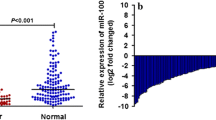Abstract
Objectives
MicroRNAs regulate gene expression at the post-transcriptional level and play important roles in cancer development, progression, and metastasis. The aim of this study was to investigate the expression of miR-92a in colorectal cancer and the normal adjacent mucosa and its potential relevance to clinicopathological characteristics and patient survival.
Methods
Surgical specimens of cancer tissue and adjacent normal mucosa were obtained from 82 patients with colorectal carcinomas. The relative expression levels of miR-92a mRNA in the cancer and the normal adjacent mucosa were measured by quantitative real-time reverse transcriptase polymerase chain reaction. We analyzed their correlation with tumor metastasis, clinicopathologic parameters, and clinical outcome.
Results
The relative expression levels of miR-92a were significantly higher in colorectal cancer tissues than in the normal adjacent mucosa (p < 0.001), and a high expression of miR-92a correlated with advanced clinical stage (p = 0.025), lymph node metastases (p = 0.015), and distant metastases (p = 0.046). Kaplan–Meier analysis indicated that patients with high miR-92a expression had a poor overall survival (p = 0.001). Moreover, multivariate analysis showed that increased expression of miR-92a was an independent predictor of overall survival.
Conclusion
This study revealed that miR-92a overexpression was correlated with specific colorectal cancer biopathologic features, such as TNM stage, lymph node and distant metastases, and poor survival of the patients, indicating that miR-92a may serve as a molecular prognostic marker for colorectal cancer and disease progression.


Similar content being viewed by others
References
Huang Z, Huang D, Ni S et al (2010) (2010) Plasma microRNAs are promising novel biomarkers for early detection of colorectal cancer. Int J Cancer 127(1):118–126
Sun L, Hu H, Peng L et al (2011) P-cadherin promotes liver metastasis and is associated with poor prognosis in colon cancer. Am J Pathol 179(1):380–390
Li XM, Wang AM, Zhang J et al (2011) Down-regulation of miR-126 expression in colorectal cancer and its clinical significance. Med Oncol 28(4):1054–1057
Lagos-Quintana M, Rauhut R, Lendeckel W et al (2001) Identification of novel genes coding for small expressed RNAs. Science 294(5543):853–858
Lau NC, Lim LP, Weinstein EG et al (2001) An abundant class of tiny RNAs with probable regulatory roles in Caenorhabditis elegans. Science 294(5543):858–862
Lee RC, Ambros V (2001) An extensive class of small RNAs in Caenorhabditis elegans. Science 294(5543):862–864
Esquela-Kerscher A, Slack FJ (2006) Oncomirs—microRNAs with a role in cancer. Nat Rev Cancer 6(4):259–269
Ambros V (2004) The functions of animal microRNAs. Nature 431(7006):350–355
Hayashita Y, Osada H, Tatematsu Y et al (2005) A polycistronic microRNA cluster, miR-17-92, is overexpressed in human lung cancers and enhances cell proliferation. Cancer Res 65(21):9628–9632
Shigoka M, Tsuchida A, Matsudo T et al (2010) Deregulation of miR-92a expression is implicated in hepatocellular carcinoma development. Pathol Int 60(5):351–357
Chen ZL, Zhao XH, Wang JW et al (2011) MicroRNA-92a promotes lymph node metastasis of human esophageal squamous cell carcinoma via E-cadherin. J Biol Chem 286(12):10725–10734
Wu CW, Ng SS, Dong YJ et al (2012) Detection of miR-92a and miR-21 in stool samples as potential screening biomarkers for colorectal cancer and polyps. Gut 61(5):739–745
Huang Z, Huang D, Ni S et al (2010) Plasma microRNAs are promising novel biomarkers for early detection of colorectal cancer. Int J Cancer 127(1):118–126
Tsuchida A, Ohno S, Wu W et al (2011) miR-92 is a key oncogenic component of the miR-17-92 cluster in colon cancer. Cancer Sci 102(12):2264–2271
He L, Thomson JM, Hemann MT et al (2005) A microRNA polycistron as a potential human oncogene. Nature 435(7043):828–833
Voorhoeve PM, le Sage C, Schrier M et al (2006) A genetic screen implicates miRNA-372 and miRNA-373 as oncogenes in testicular germ cell tumors. Cell 124(6):1169–1181
Johnson SM, Grosshans H, Shingara J et al (2005) RAS is regulated by the let-7 microRNA family. Cell 120(5):635–647
Mattie MD, Benz CC, Bowers J et al (2006) Optimized high-throughput microRNA expression profiling provides novel biomarker assessment of clinical prostate and breast cancer biopsies. Mol Cancer 5:24
Yanaihara N, Caplen N, Bowman E et al (2006) Unique microRNA molecular profiles in lung cancer diagnosis and prognosis. Cancer Cell 9(3):189–198
Tanaka M, Oikawa K, Takanashi M et al (2009) Down-regulation of miR-92 in human plasma is a novel marker for acute leukemia patients. PLoS ONE 4(5):e5532
Diosdado B, van de Wiel MA, Terhaar Sive Droste JS et al (2009) MiR-17-92 cluster is associated with 13q gain and c-myc expression during colorectal adenoma to adenocarcinoma progression. Br J Cancer 101(4):707–714
Connolly E, Melegari M, Landgraf P et al (2008) Elevated expression of the miR-17-92 polycistron and miR-21 in hepadnavirus-associated hepatocellular carcinoma contributes to the malignant phenotype. Am J Pathol 173(3):856–864
Ventura A, Young AG, Winslow MM et al (2008) Targeted deletion reveals essential and overlapping functions of the miR-17 through 92 family of miRNA clusters. Cell 132(5):875–886
Bonauer A, Carmona G, Iwasaki M et al (2009) MicroRNA-92a controls angiogenesis and functional recovery of ischemic tissues in mice. Science 324(5935):1710–1713
Manni I, Artuso S, Careccia S et al (2009) The microRNA miR-92 increases proliferation of myeloid cells and by targeting p63 modulates the abundance of its isoforms. FASEB J 23(11):3957–3966
Ghosh AK, Shanafelt TD, Cimmino A et al (2009) Aberrant regulation of pVHL levels by microRNA promotes the HIF/VEGF axis in CLL B cells. Blood 113(22):5568–5574
Acknowledgments
This work was supported by Scientific Research Program of Sichuan Provincial Health Department of China (110319).
Conflict of interest
The authors declare that no conflicts of interest exist.
Author information
Authors and Affiliations
Corresponding author
Rights and permissions
About this article
Cite this article
Zhou, T., Zhang, G., Liu, Z. et al. Overexpression of miR-92a correlates with tumor metastasis and poor prognosis in patients with colorectal cancer. Int J Colorectal Dis 28, 19–24 (2013). https://doi.org/10.1007/s00384-012-1528-1
Accepted:
Published:
Issue Date:
DOI: https://doi.org/10.1007/s00384-012-1528-1




